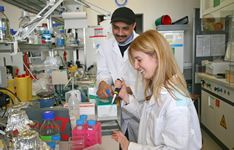2008 SwissTB Award
Nicole Scherr and Dr. Srinivas Honnappa
 We describe the crystal structure of protein kinase G, a crucial virulence factor from pathogenic mycobacteria in complex with a highly specific and potent inhibitor. Protein kinase G is a eukaryotic serine/threonine kinase that is essential for the intracellular survival of pathogenic mycobacteria inside macrophages. Previously, an inhibitor for protein kinase G was defined that induced mycobacterial killing of internalized mycobacteria. Given the relative simple structure of this inhibitor and the high homology of mycobacterial protein kinase G to eukaryotic kinases, the specificity and selectivity of this inhibitor was puzzling. The crystal structure now shows that the ATP binding pocket of protein kinase G is unique, in that it is characterized by a combination of amino acid residues that is not found in any of the > 500 human kinases analyzed; strikingly, it is exactly this stretch of residues that are prominently interacting with the protein kinase G-specific inhibitor. The finding that unique sequences can be defined within the ATP binding pocket of protein kinase G is important for the development of drugs to combat tuberculosis. The development of novel drugs and vaccines to combat mycobacterial diseases such as tuberculosis are at the forefront of research, given the severity of the disease as well as the development of drug resistance against virtually all available clinically used compounds. Furthermore, Protein Kinase G is an attractive drug target in that (1) kinases have recently been shown to be valid drug targets and (2) blocking Protein Kinase G allows the macrophage to carry out its innate anti-mycobacterial activity. To overcome the subversion of the macrophage anti-microbial function is currently one of the roadblocks in the development of effective anti-tuberculosis therapy.
We describe the crystal structure of protein kinase G, a crucial virulence factor from pathogenic mycobacteria in complex with a highly specific and potent inhibitor. Protein kinase G is a eukaryotic serine/threonine kinase that is essential for the intracellular survival of pathogenic mycobacteria inside macrophages. Previously, an inhibitor for protein kinase G was defined that induced mycobacterial killing of internalized mycobacteria. Given the relative simple structure of this inhibitor and the high homology of mycobacterial protein kinase G to eukaryotic kinases, the specificity and selectivity of this inhibitor was puzzling. The crystal structure now shows that the ATP binding pocket of protein kinase G is unique, in that it is characterized by a combination of amino acid residues that is not found in any of the > 500 human kinases analyzed; strikingly, it is exactly this stretch of residues that are prominently interacting with the protein kinase G-specific inhibitor. The finding that unique sequences can be defined within the ATP binding pocket of protein kinase G is important for the development of drugs to combat tuberculosis. The development of novel drugs and vaccines to combat mycobacterial diseases such as tuberculosis are at the forefront of research, given the severity of the disease as well as the development of drug resistance against virtually all available clinically used compounds. Furthermore, Protein Kinase G is an attractive drug target in that (1) kinases have recently been shown to be valid drug targets and (2) blocking Protein Kinase G allows the macrophage to carry out its innate anti-mycobacterial activity. To overcome the subversion of the macrophage anti-microbial function is currently one of the roadblocks in the development of effective anti-tuberculosis therapy.  Knowledge of the structure presented in our manuscript will be crucial in the design of compounds that may be useful to target the growth of pathogenic mycobacteria within host macrophages by a novel concept, namely by allowing macrophages to carry out their innate anti-mycobacterial activity thereby circumventing the problem of accessibility of drugs to the mycobacteria. We believe that our findings are of high actual interest in the tuberculosis field. As mentioned above, there is a great need for new drugs to combat tuberculosis and our results may significantly contribute to the development of such drugs. In addition, Protein Kinase G as a promising anti-tuberculosis drug target is in the process of being evaluated as a vaccine candidate.
Knowledge of the structure presented in our manuscript will be crucial in the design of compounds that may be useful to target the growth of pathogenic mycobacteria within host macrophages by a novel concept, namely by allowing macrophages to carry out their innate anti-mycobacterial activity thereby circumventing the problem of accessibility of drugs to the mycobacteria. We believe that our findings are of high actual interest in the tuberculosis field. As mentioned above, there is a great need for new drugs to combat tuberculosis and our results may significantly contribute to the development of such drugs. In addition, Protein Kinase G as a promising anti-tuberculosis drug target is in the process of being evaluated as a vaccine candidate.
Publication
Structural basis for the specific inhibition of protein kinase G, a virulence factor of Mycobacterium tuberculosis.
Nicole Scherr*, Srinivas Honnappa†, Gabriele Kunz*, Philipp Mueller*, Rajesh Jayachandran*, Fritz Winkler†, Jean Pieters*†, and Michel O. Steinmetz†
* Biozentrum, University of Basel, CH-4056 Basel, Switzerland; † Biomolecular Research, Structural Biology, Paul Scherrer Insititut, CH-5232 Villigen PSI, Switzerland
